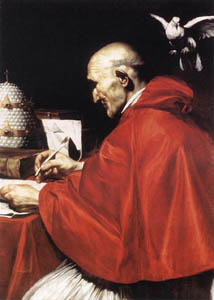
ST. GREGORY THE GREAT SHOWS THE WAY
By Patricius Anthony
TRADITIO Traditional Roman Catholic Internet Site
E-mail: traditio@traditio.com, Web: http://www.traditio.com
Copyright 2006 P. Anthony. Reproduction prohibited without authorization.

During the holy season of Lent, the feastdays of some of the Church's most illustrious Saints falling then can be overlooked, as Catholics naturally turn their devotional attention to commemorate Christ's sufferings and passion. This is the case with Pope St. Gregory the Great (540-609), one of the Four Great Latin Doctors of the Church.
There are many facets of St. Gregory's life which place him in the august company of Sts. Augustine, Ambrose, and Jerome, the other three Great Latin Doctors of the Church: his personal piety, his arrangement of Sacred Chant texts and melodies, his ecclesiastical reforms, and his vast evangelical efforts. It is too bad that 20th-century Catholics were not as vigilant as their Roman ancestors, who took significant umbrage with anyone, including a pope, who would tamper with an Apostolic rite especially the rite of Christendom.
While St. Gregory's attention to the Apostolic Mass itself proved to be divinely inspired, often overlooked has been his work on the Divine Office. And, like the authentic Mass, the Saint's imprint can still be felt today by the loyal traditional Catholic priesthood, religious, and those of the laity who faithfully recite the daily Hours of Divine praise.
As Fr. Adrian Fortescue did in his exhaustive study entitled The Mass: A Study of the Roman Liturgy, disproving the claims that the Eastern liturgies were more venerable than that of Rome, Velma Little in her superb book, The Sacrifice of Praise, similarly substantiates that the make-up, regulation, and practices of the Office were eminently Roman:
St. Gregory the Great restored the ancient rhythm of psalmody and gave the final shape to the Roman Office. He based his arrangement on that of St. Benedict, being himself a Benedictine monk. Now St. Benedict, as he himself tells us, had followed the liturgical customs of the Rome of his day, so it follows that there is no fundamental difference between the Roman and the monastic Use since both spring from the same parent stem: the original old Roman rite.
Little's half century of research on the matter describes the impact of the great Saint:
The influence of St. Gregory on the Office was to prove permanent. He had the true Roman sense of balance and shapely form which to this day, in spite of revisions and alterations, remain the characteristic features of the Roman Office. The main lines of the ffice are thus fixed from the time of St. Gregory.
That Newchurch would knowingly abandon one of the great pillars of Tradition even more venerable than the compilation of the New Testament itself can be attributable only to the diabolical. Those responsible for such an act, where the Apostolic and, thus, proper worship of Almighty God has been replaced with something created by man, will surely face, to say the least, a grim eternal future.
The current deplorable state of both the papacy and the Church are the baneful fruits of Modernistic thought adopted and implemented by the Conciliar popes. These cretins have wantonly abandoned, suppressed, and destroyed (when possible) all of the efforts of great Saints, such as Gregory, to pass down the precious Apostolic Faith. These are nothing but criminal acts and should be treated as such by Catholics who are serious about Christ and their own salvation.
Those groups and organizations who seek to compromise with the Conciliar popes and their treacherous minions to gain some sort of acceptance or legitimacy should likewise be condemned. How could any real Catholic negotiate with some of the very individuals responsible for the replacement of the Holy Sacrifice of the Mass, the greatest gift ever bestowed on mankind, with the abominable Novus Ordo worship service and, even worse, the substitution of the Divine Office with the so-called "Liturgy of the Hours"?!
The lives of the Saints are not only inspirational but can also provide practical wisdom and strategies for Catholics living in an age of apostasy. Initiatives such as the republication of the Breviarium Romanum, preferably the version prior to the "reform" of 1956, is just one project that needs to be undertaken. Instead of meetings with representatives of the Counterfeit Church, who have no interest in a return to Tradition, the publication of a set of Benziger's Breviary volumes from the early 1940s would do more for the revival of the Faith than any agreement with Newrome.
While St. Gregory did not face the internal apostasy so pervasive today, he still had to deal with, among other crises, the disintegration of the Roman Empire. Yet, through all the troubles, his mindset, as demonstrated in his work on the Divine Office, was that of a Roman Catholic pope. If ever authentic Christianity is to be restored among the peoples and lands where it once flourished so splendidly, it will be because future popes and Catholics will think as St. Gregory did.